TOYOTA HIGHLANDER 2017 XU50 / 3.G Owners Manual
Manufacturer: TOYOTA, Model Year: 2017, Model line: HIGHLANDER, Model: TOYOTA HIGHLANDER 2017 XU50 / 3.GPages: 732, PDF Size: 12.34 MB
Page 661 of 732
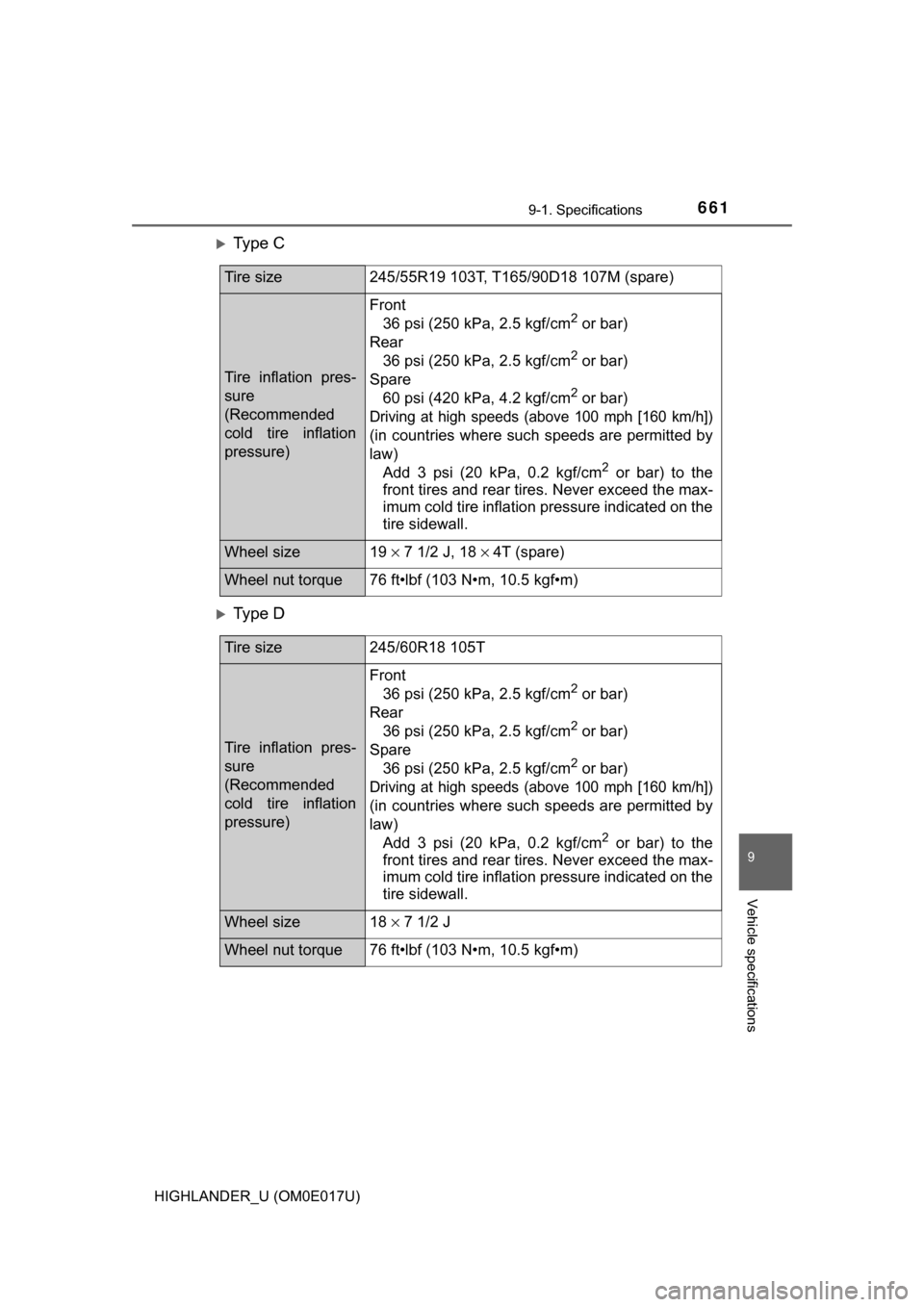
6619-1. Specifications
9
Vehicle specifications
HIGHLANDER_U (OM0E017U)
Ty p e C
Ty p e D
Tire size245/55R19 103T, T165/90D18 107M (spare)
Tire inflation pres-
sure
(Recommended
cold tire inflation
pressure)
Front36 psi (250 kPa, 2.5 kgf/cm2 or bar)
Rear 36 psi (250 kPa, 2.5 kgf/cm
2 or bar)
Spare 60 psi (420 kPa, 4.2 kgf/cm
2 or bar)
Driving at high speeds (above 100 mph [160 km/h])
(in countries where such speeds are permitted by
law)Add 3 psi (20 kPa, 0.2 kgf/cm
2 or bar) to the
front tires and rear tires. Never exceed the max-
imum cold tire inflation pressure indicated on the
tire sidewall.
Wheel size19 × 7 1/2 J, 18 × 4T (spare)
Wheel nut torque76 ft•lbf (103 N•m, 10.5 kgf•m)
Tire size245/60R18 105T
Tire inflation pres-
sure
(Recommended
cold tire inflation
pressure)
Front
36 psi (250 kPa, 2.5 kgf/cm2 or bar)
Rear 36 psi (250 kPa, 2.5 kgf/cm
2 or bar)
Spare 36 psi (250 kPa, 2.5 kgf/cm
2 or bar)
Driving at high speeds (above 100 mph [160 km/h])
(in countries where such speeds are permitted by
law)Add 3 psi (20 kPa, 0.2 kgf/cm
2 or bar) to the
front tires and rear tires. Never exceed the max-
imum cold tire inflation pressure indicated on the
tire sidewall.
Wheel size18 × 7 1/2 J
Wheel nut torque76 ft•lbf (103 N•m, 10.5 kgf•m)
Page 662 of 732
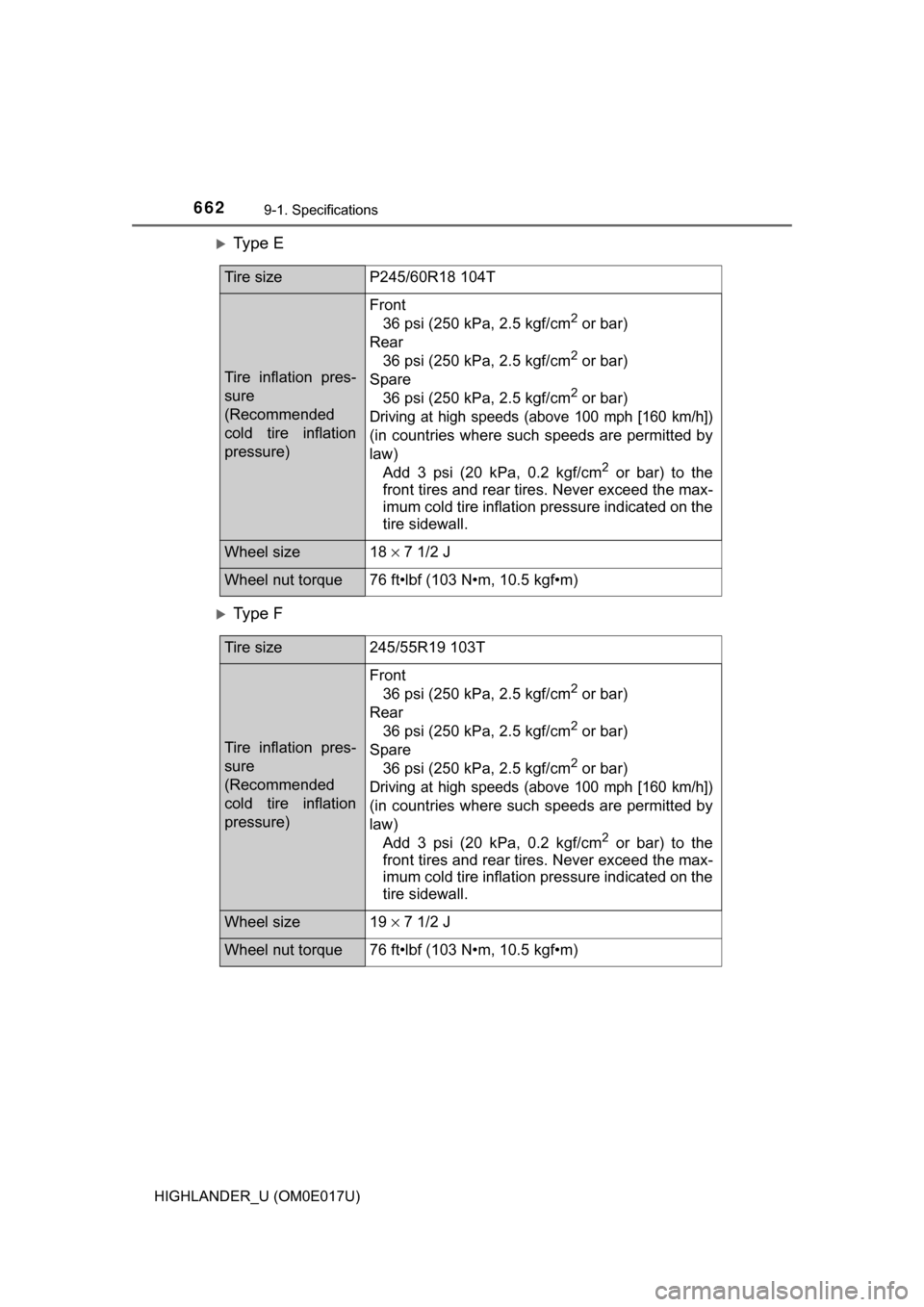
6629-1. Specifications
HIGHLANDER_U (OM0E017U)
Ty p e E
Ty p e F
Tire sizeP245/60R18 104T
Tire inflation pres-
sure
(Recommended
cold tire inflation
pressure)
Front36 psi (250 kPa, 2.5 kgf/cm2 or bar)
Rear 36 psi (250 kPa, 2.5 kgf/cm
2 or bar)
Spare 36 psi (250 kPa, 2.5 kgf/cm
2 or bar)
Driving at high speeds (above 100 mph [160 km/h])
(in countries where such speeds are permitted by
law)Add 3 psi (20 kPa, 0.2 kgf/cm
2 or bar) to the
front tires and rear tires. Never exceed the max-
imum cold tire inflation pressure indicated on the
tire sidewall.
Wheel size18 × 7 1/2 J
Wheel nut torque76 ft•lbf (103 N•m, 10.5 kgf•m)
Tire size245/55R19 103T
Tire inflation pres-
sure
(Recommended
cold tire inflation
pressure)
Front
36 psi (250 kPa, 2.5 kgf/cm2 or bar)
Rear 36 psi (250 kPa, 2.5 kgf/cm
2 or bar)
Spare 36 psi (250 kPa, 2.5 kgf/cm
2 or bar)
Driving at high speeds (above 100 mph [160 km/h])
(in countries where such speeds are permitted by
law)Add 3 psi (20 kPa, 0.2 kgf/cm
2 or bar) to the
front tires and rear tires. Never exceed the max-
imum cold tire inflation pressure indicated on the
tire sidewall.
Wheel size19 × 7 1/2 J
Wheel nut torque76 ft•lbf (103 N•m, 10.5 kgf•m)
Page 663 of 732
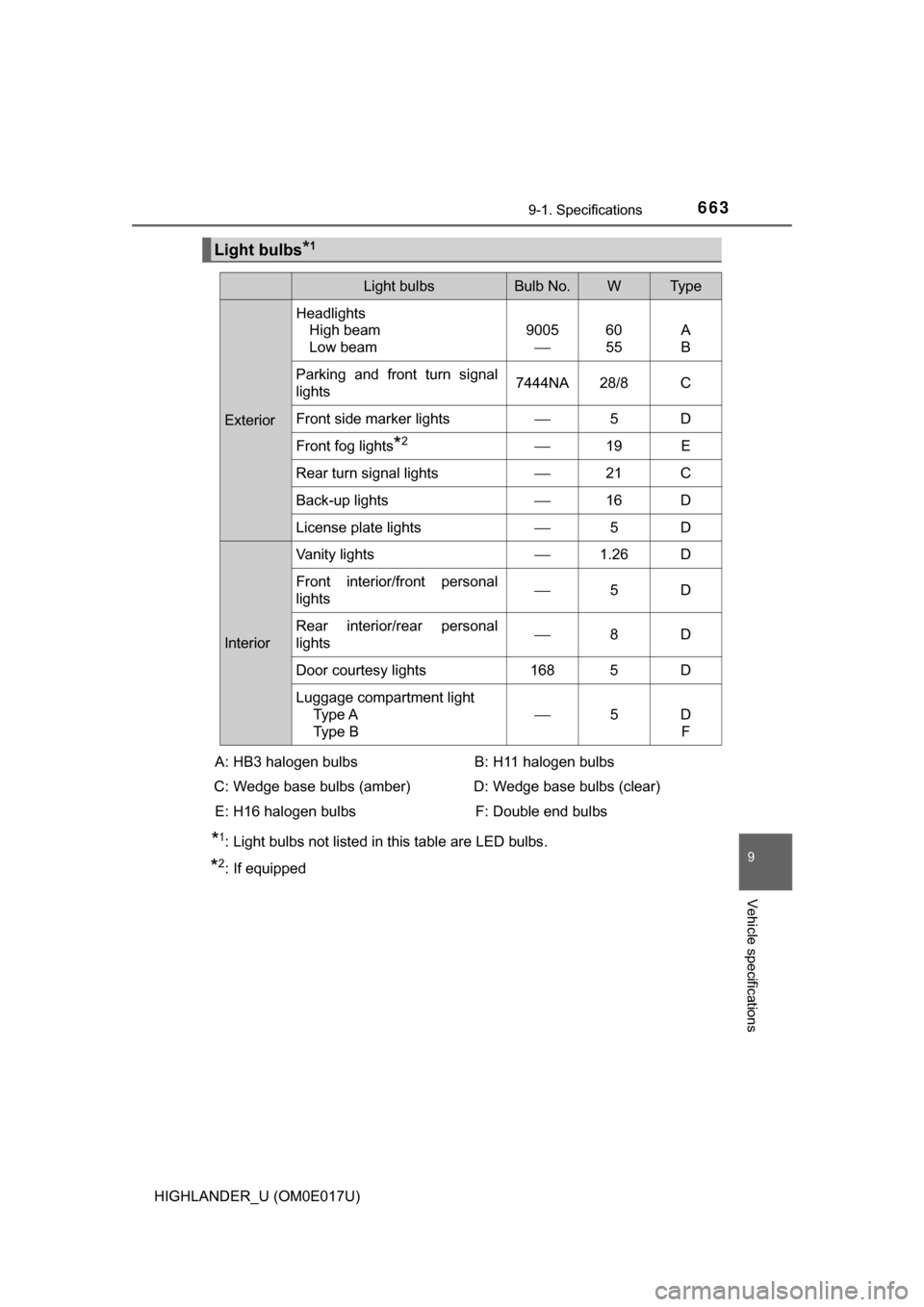
6639-1. Specifications
9
Vehicle specifications
HIGHLANDER_U (OM0E017U)
*1: Light bulbs not listed in this table are LED bulbs.
*2: If equipped
Light bulbs*1
Light bulbsBulb No.WTy p e
ExteriorHeadlights
High beam
Low beam 9005
⎯ 60
55 A
B
Parking and front turn signal
lights 7444NA 28/8 C
Front side marker lights ⎯5D
Front fog lights
*2⎯ 19 E
Rear turn signal lights ⎯21 C
Back-up lights ⎯16 D
License plate lights ⎯5D
InteriorVanity lights
⎯1.26 D
Front interior/front personal
lights ⎯
5D
Rear interior/rear personal
lights ⎯
8D
Door courtesy lights 168 5 D
Luggage compartment light Type A
Type B ⎯
5D
F
A: HB3 halogen bulbs
C: Wedge base bulbs (amber)
E: H16 halogen bulbs B: H11 halogen bulbs
D: Wedge base bulbs (clear)
F: Double end bulbs
Page 664 of 732
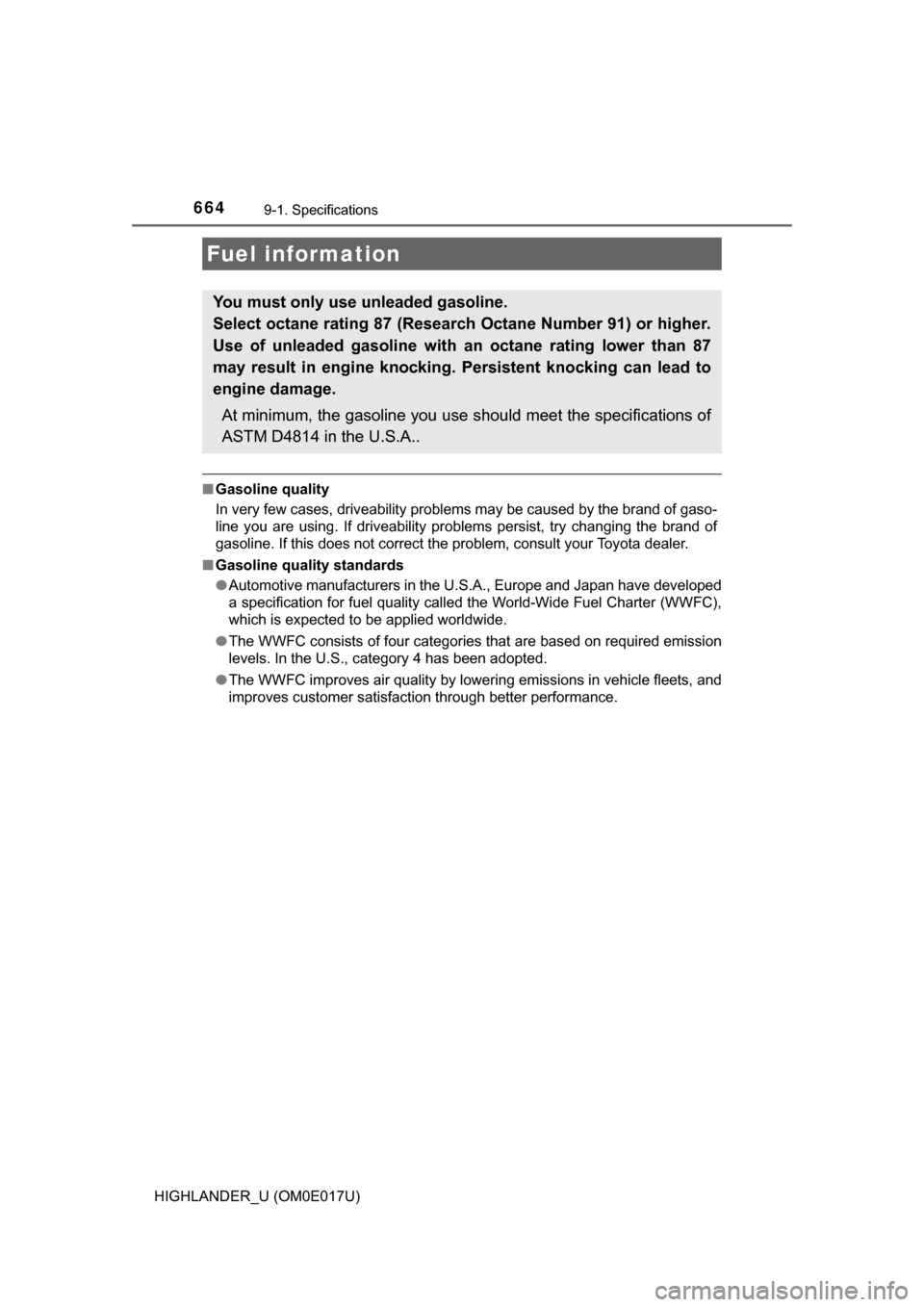
6649-1. Specifications
HIGHLANDER_U (OM0E017U)
■Gasoline quality
In very few cases, driveability problems may be caused by the brand of gaso-
line you are using. If driveability problems persist, try changing the brand of
gasoline. If this does not correct the problem, consult your Toyota dealer.
■ Gasoline quality standards
●Automotive manufacturers in the U.S.A., Europe and Japan have developed
a specification for fuel quality called the World-Wide Fuel Charter (WWFC),
which is expected to be applied worldwide.
● The WWFC consists of four categor ies that are based on required emission
levels. In the U.S., category 4 has been adopted.
● The WWFC improves air quality by lowering emissions in vehicle fleets, and
improves customer satisfaction through better performance.
Fuel information
You must only use unleaded gasoline.
Select octane rating 87 (Research Octane Number 91) or higher.
Use of unleaded gasoline with an octane rating lower than 87
may result in engine knocking. Persistent knocking can lead to
engine damage.
At minimum, the gasoline you use s hould meet the specifications of
ASTM D4814 in the U.S.A..
Page 665 of 732
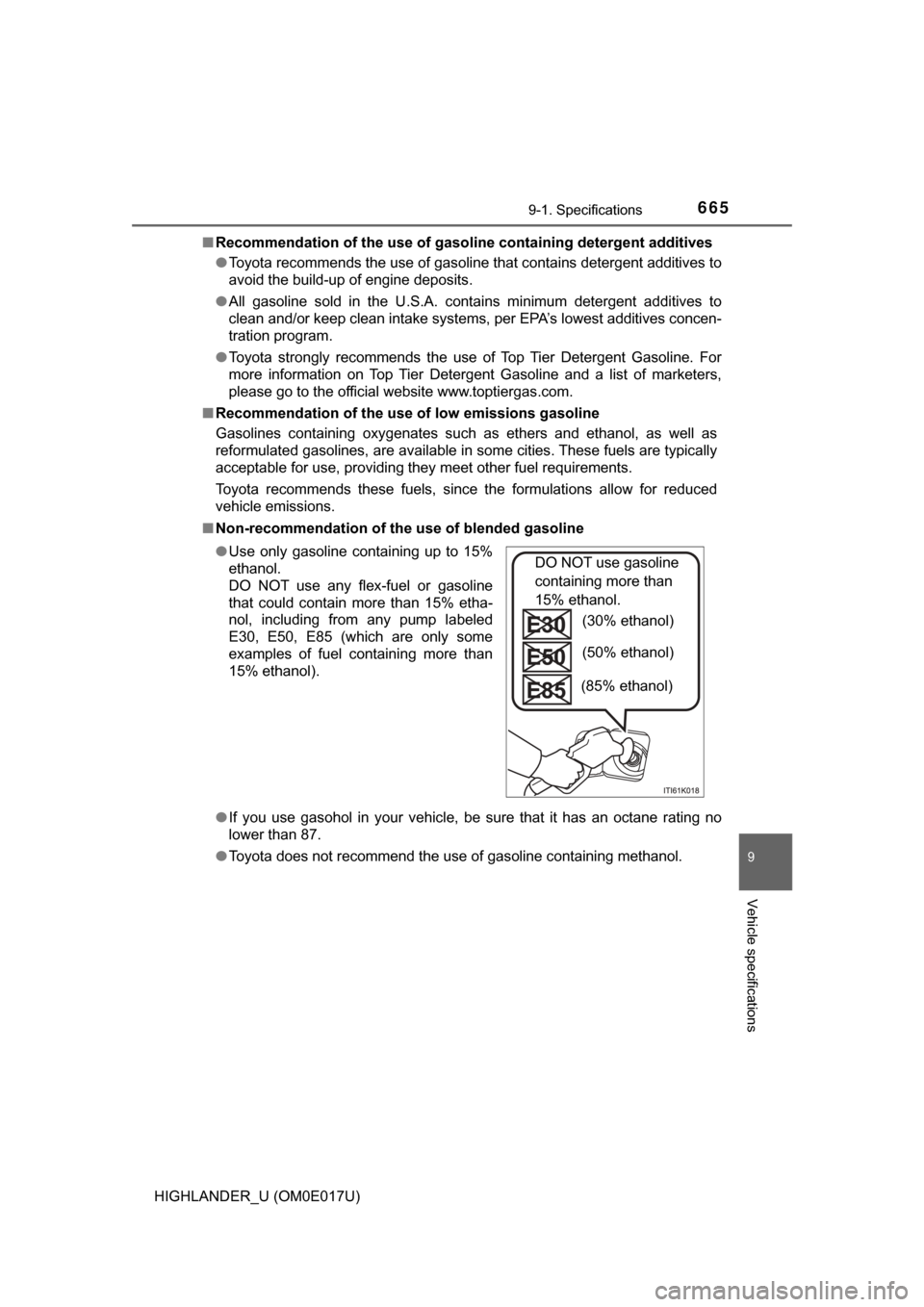
6659-1. Specifications
9
Vehicle specifications
HIGHLANDER_U (OM0E017U)■
Recommendation of the use of gaso line containing detergent additives
● Toyota recommends the use of gasoline that contains detergent additives to
avoid the build-up of engine deposits.
● All gasoline sold in the U.S.A. contains minimum detergent additives to
clean and/or keep clean intake systems, per EPA’s lowest additives concen-
tration program.
● Toyota strongly recommends the use of Top Tier Detergent Gasoline. For
more information on Top Tier Detergent Gasoline and a list of marketers,
please go to the official website www.toptiergas.com.
■ Recommendation of the use of low emissions gasoline
Gasolines containing oxygenates such as ethers and ethanol, as well as
reformulated gasolines, are available in some cities. These fuels are typically
acceptable for use, providing they meet other fuel requirements.
Toyota recommends these fuels, since the formulations allow for reduced
vehicle emissions.
■ Non-recommendation of the use of blended gasoline
●If you use gasohol in your vehicle, be sure that it has an octane rating no
lower than 87.
● Toyota does not recommend the use of gasoline containing methanol.
●
Use only gasoline containing up to 15%
ethanol.
DO NOT use any flex-fuel or gasoline
that could contain more than 15% etha-
nol, including from any pump labeled
E30, E50, E85 (which are only some
examples of fuel containing more than
15% ethanol).
DO NOT use gasoline
containing more than
15% ethanol.
(30% ethanol)
(50% ethanol)
(85% ethanol)
Page 666 of 732
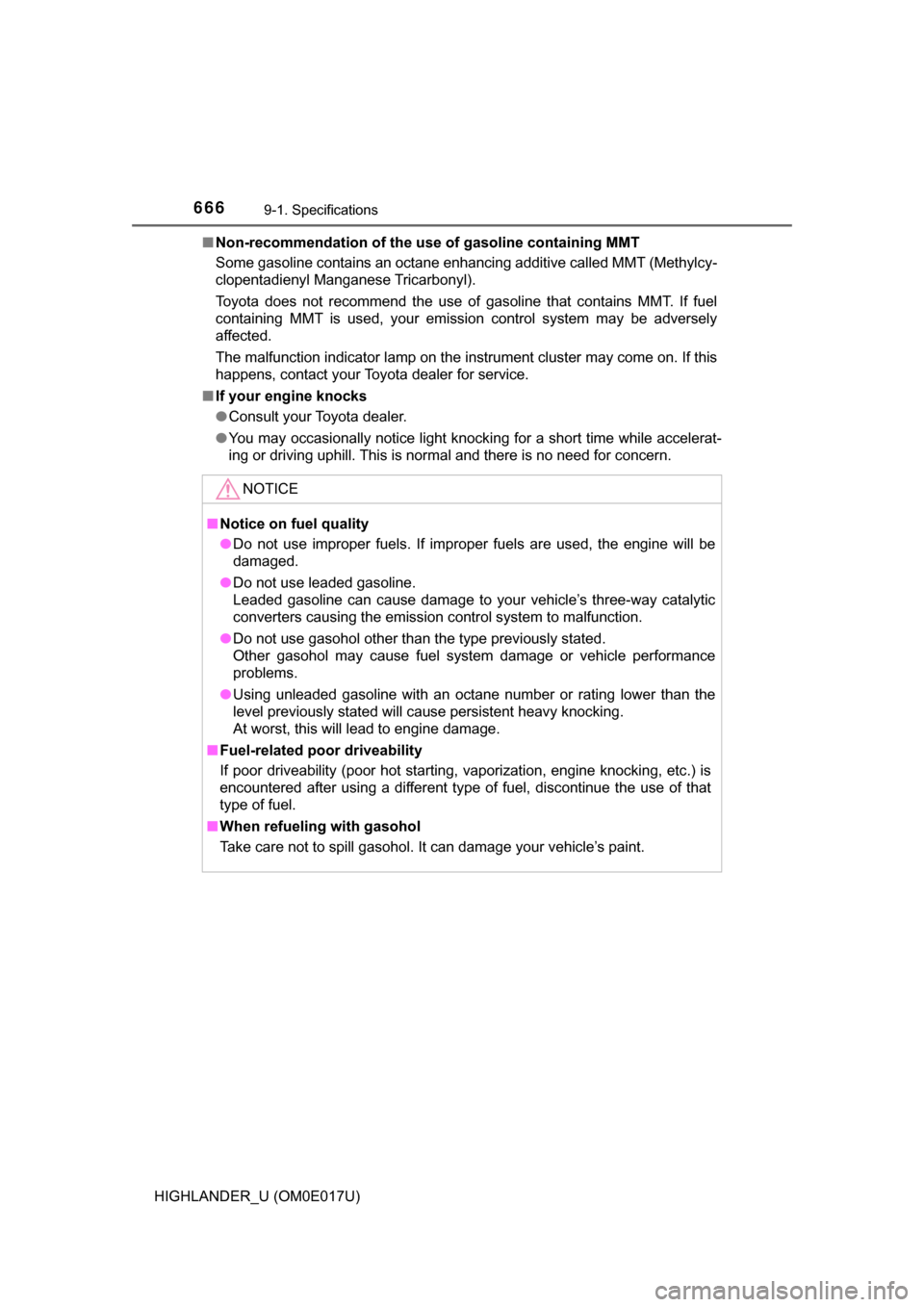
6669-1. Specifications
HIGHLANDER_U (OM0E017U)■
Non-recommendation of the use of gasoline containing MMT
Some gasoline contains an octane enhancing additive called MMT (Methylcy-
clopentadienyl Manganese Tricarbonyl).
Toyota does not recommend the use of gasoline that contains MMT. If fuel
containing MMT is used, your emission control system may be adversely
affected.
The malfunction indicator lamp on the instrument cluster may come on. If this
happens, contact your Toyota dealer for service.
■ If your engine knocks
●Consult your Toyota dealer.
● You may occasionally notice light knocking for a short time while accelerat-
ing or driving uphill. This is normal and there is no need for concern.
NOTICE
■Notice on fuel quality
● Do not use improper fuels. If improper fuels are used, the engine will be
damaged.
● Do not use leaded gasoline.
Leaded gasoline can cause damage to your vehicle’s three-way catalytic
converters causing the emission control system to malfunction.
● Do not use gasohol other than the type previously stated.
Other gasohol may cause fuel system damage or vehicle performance
problems.
● Using unleaded gasoline with an octane number or rating lower than the
level previously stated will cause persistent heavy knocking.
At worst, this will lead to engine damage.
■ Fuel-related poor driveability
If poor driveability (poor hot starting, vaporization, engine knocking, etc.) is
encountered after using a different type of fuel, discontinue the use of that
type of fuel.
■ When refueling with gasohol
Take care not to spill gasohol. It can damage your vehicle’s paint.
Page 667 of 732
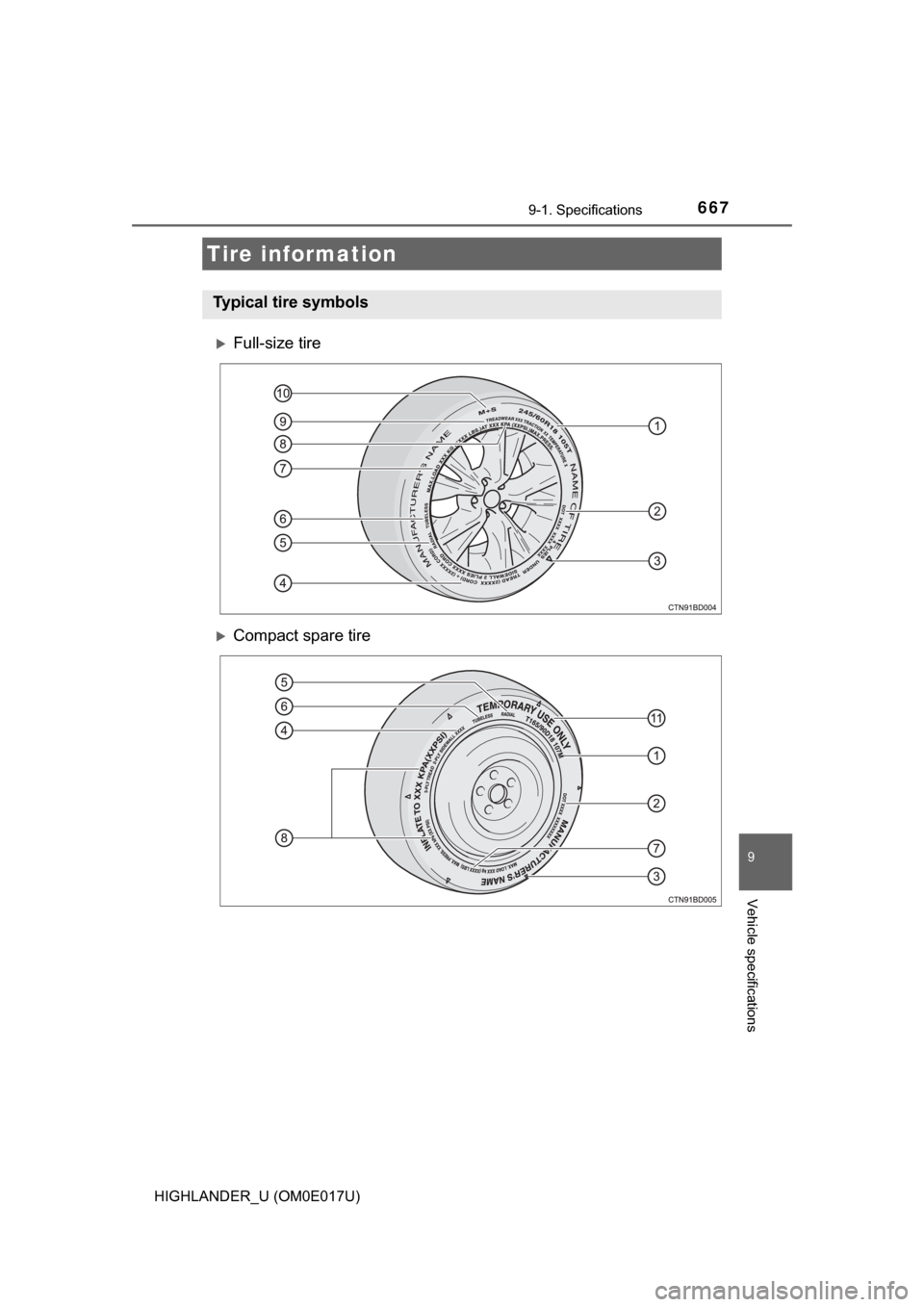
6679-1. Specifications
9
Vehicle specifications
HIGHLANDER_U (OM0E017U)
Full-size tire
Compact spare tire
Tire information
Typical tire symbols
Page 668 of 732
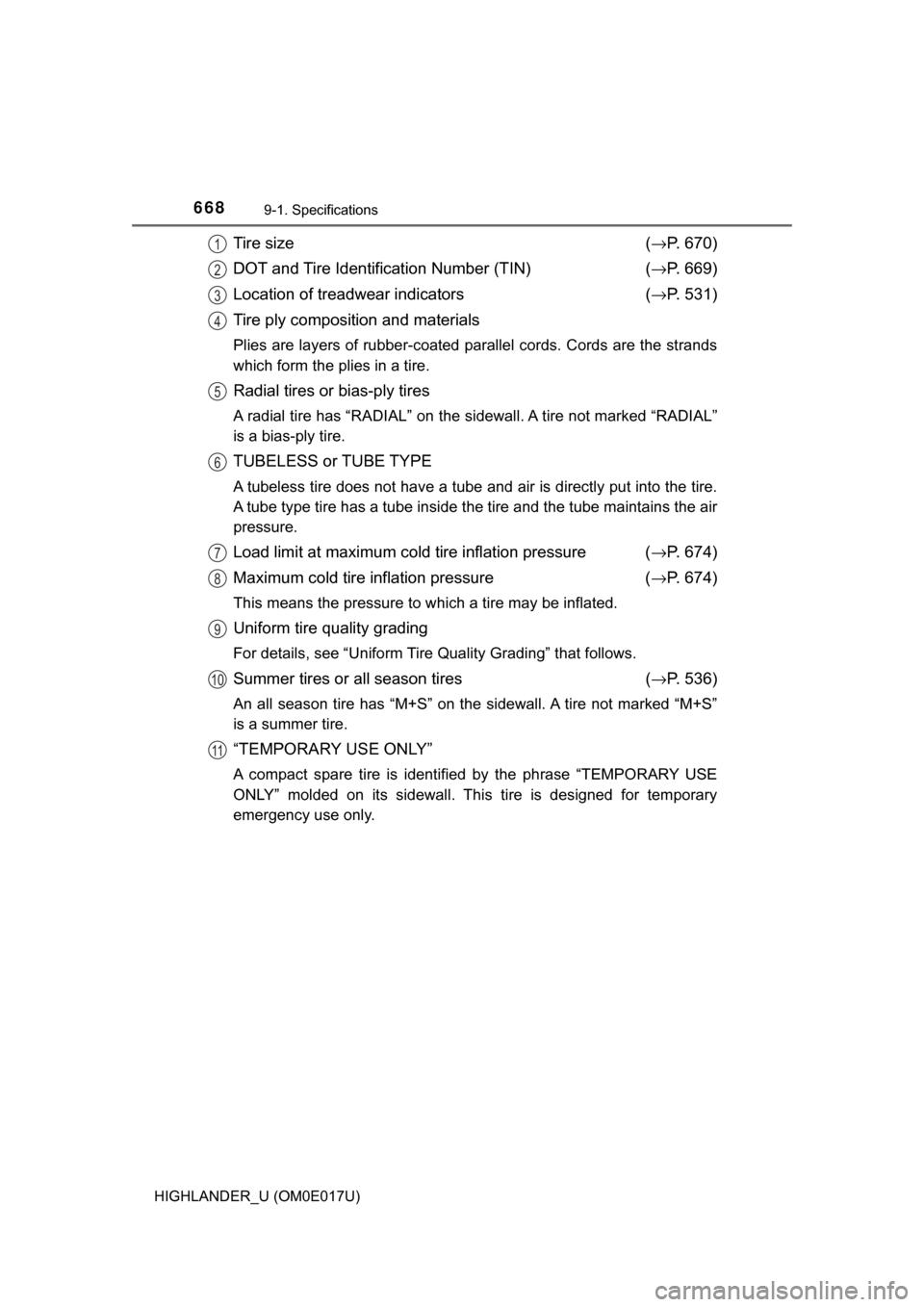
6689-1. Specifications
HIGHLANDER_U (OM0E017U)
Tire size (→ P. 670)
DOT and Tire Identification Number (TIN) (→P. 669)
Location of treadwear indicators (→ P. 531)
Tire ply composition and materials
Plies are layers of rubber-coated parallel cords. Cords are the strands
which form the plies in a tire.
Radial tires or bias-ply tires
A radial tire has “RADIAL” on the sidewall. A tire not marked “RADIAL”
is a bias-ply tire.
TUBELESS or TUBE TYPE
A tubeless tire does not have a tube and air is directly put into the tire.
A tube type tire has a tube inside the tire and the tube maintains the air
pressure.
Load limit at maximum cold tire inflation pressure ( →P. 674)
Maximum cold tire inflation pressure (→ P. 674)
This means the pressure to which a tire may be inflated.
Uniform tire quality grading
For details, see “Uniform Tire Quality Grading” that follows.
Summer tires or all season tires (→ P. 536)
An all season tire has “M+S” on the sidewall. A tire not marked “M+S”
is a summer tire.
“TEMPORARY USE ONLY”
A compact spare tire is identified by the phrase “TEMPORARY USE
ONLY” molded on its sidewall. This tire is designed for temporary
emergency use only.
1
2
3
4
5
6
7
8
9
10
11
Page 669 of 732
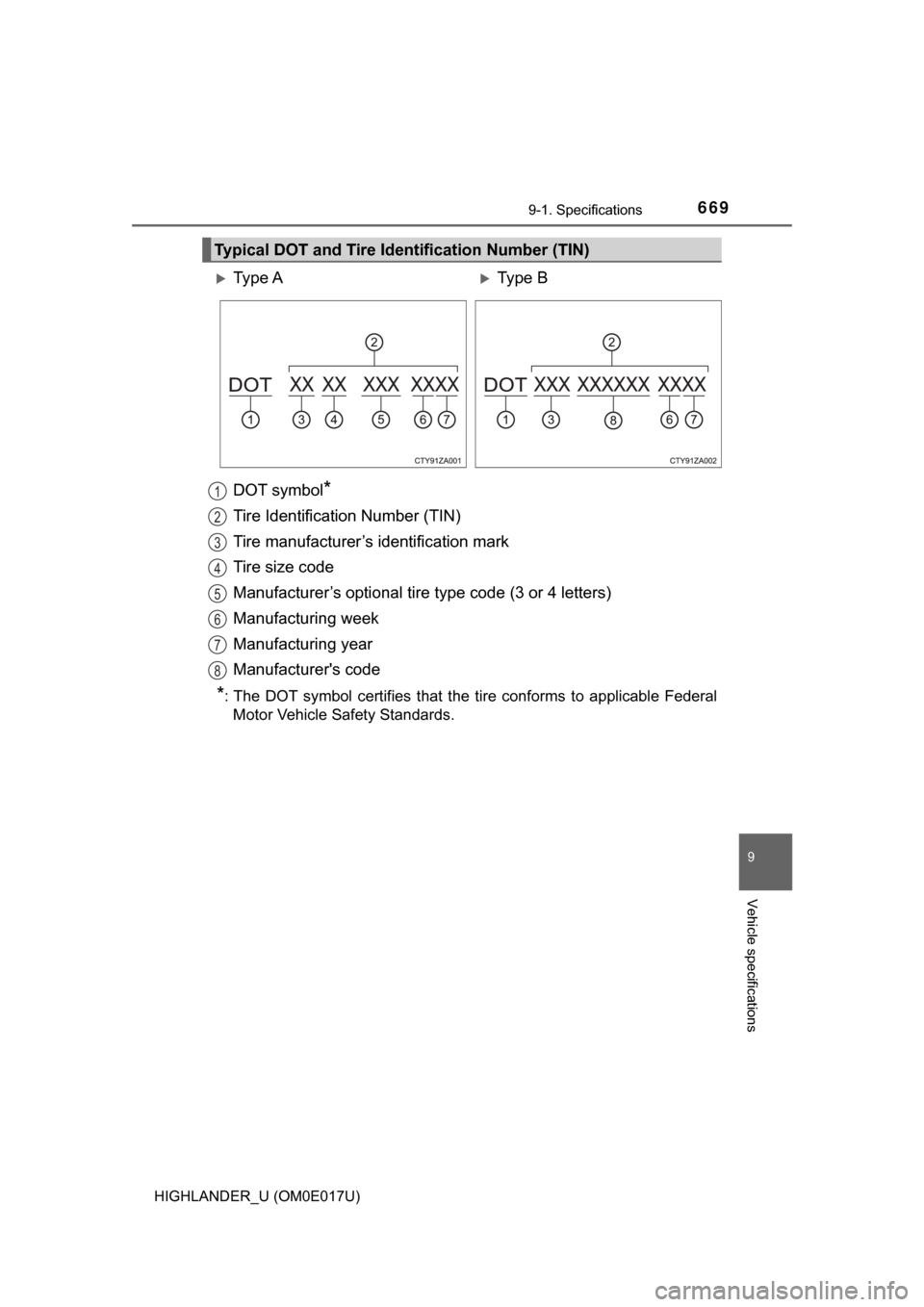
6699-1. Specifications
9
Vehicle specifications
HIGHLANDER_U (OM0E017U)
DOT symbol*
Tire Identification Number (TIN)
Tire manufacturer’s identification mark
Tire size code
Manufacturer’s optional tire type code (3 or 4 letters)
Manufacturing week
Manufacturing year
Manufacturer's code
*: The DOT symbol certifies that the tire conforms to applicable Federal Motor Vehicle Safety Standards.
Typical DOT and Tire Identification Number (TIN)
Ty p e AType B
1
2
3
4
5
6
7
8
Page 670 of 732
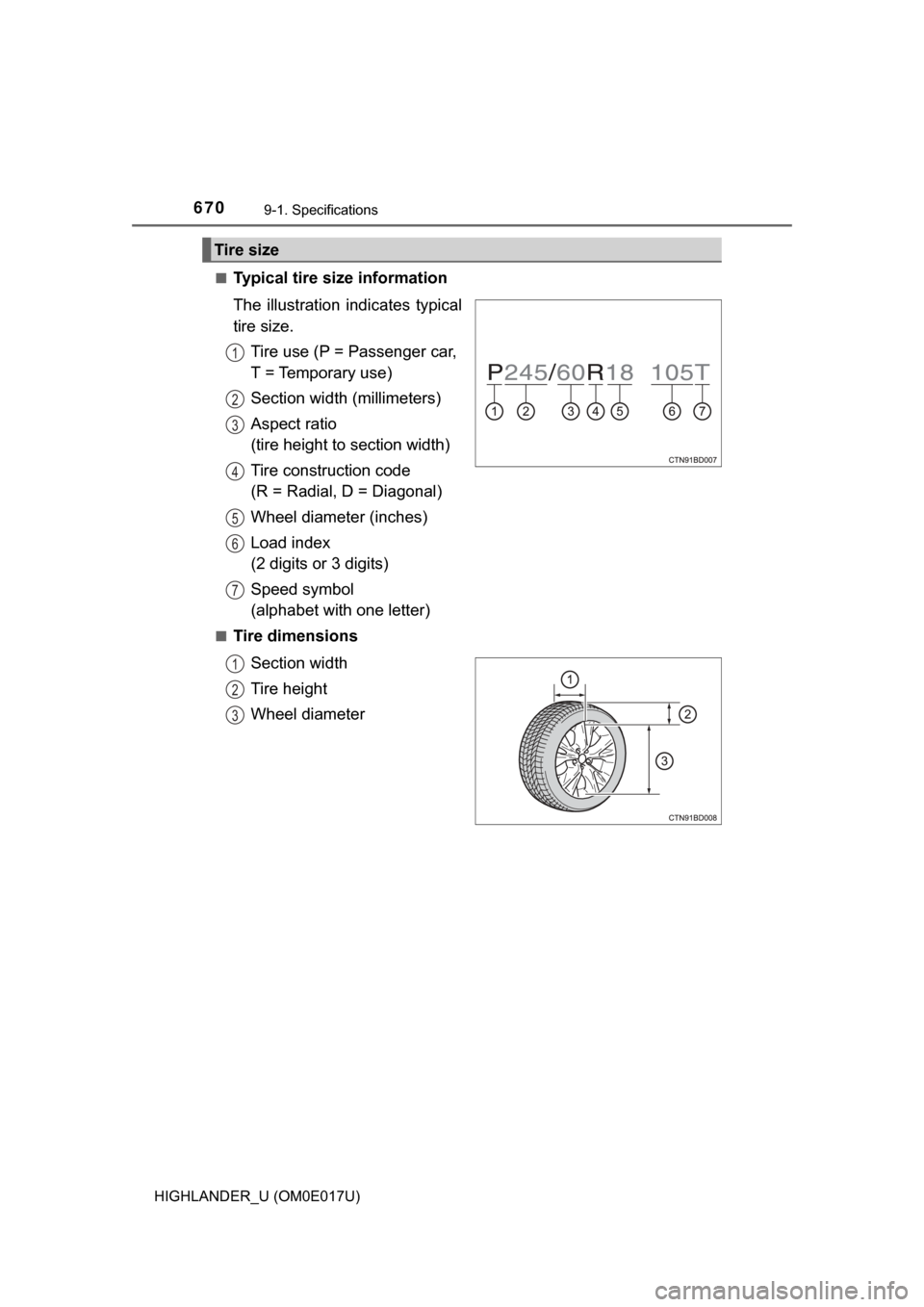
6709-1. Specifications
HIGHLANDER_U (OM0E017U)■
Typical tire size information
The illustration in
dicates typical
tire size.
Tire use (P = Passenger car,
T = Temporary use)
Section width (millimeters)
Aspect ratio
(tire height to section width)
Tire construction code
(R = Radial, D = Diagonal)
Wheel diameter (inches)
Load index
(2 digits or 3 digits)
Speed symbol
(alphabet with one letter)
■Tire dimensions
Section width
Tire height
Wheel diameter
Tire size
1
2
3
4
5
6
7
1
2
3